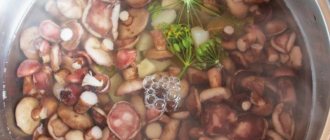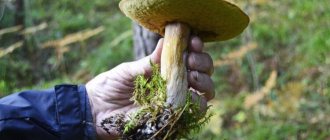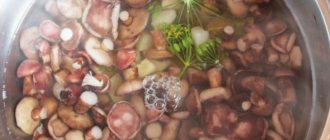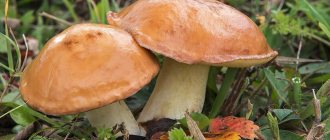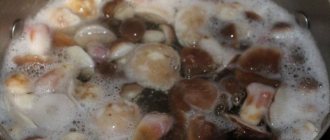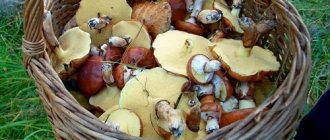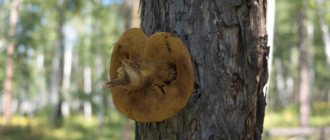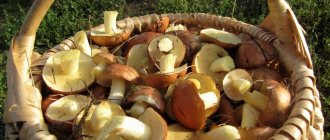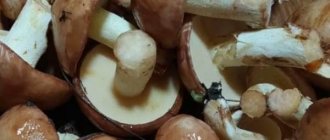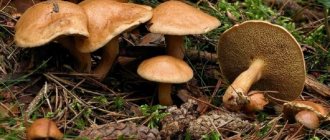Appearance and description are oily
It cannot be said that boletus have a unique appearance. There are many mushrooms similar to them. However, this species has certain features unique to it.
hat
's cap
The appearance of the oiler's cap changes as it grows.
In young mushrooms it is conical, convex in shape. But as it matures, the surface gradually stretches out, but never becomes smooth. Interesting fact : the maximum diameter of the cap of adult butter mushrooms is 15 cm. On average, this parameter is in the range from 10 to 12 cm.
The cap of butter mushrooms, unlike other mushrooms, is covered with a thin skin. It feels damp and slimy to the touch. Thanks to it, the surface shines in the light. The structure of the film depends on the type of mushroom. For some, it can crack into small sectors in the future or become porous. The color of the skin can be brown, yellow, orange. Moreover, the color does not depend on the species, but on the degree of lighting in the forest: the more rays hitting the surface, the lighter it is.
Hymenophore
Hymenophore oiler
Hymenophore is the spore-bearing layer of mushrooms located on the inner layer of the cap. In butterfish it has a porous structure. It completely covers the area under the cap and consists of thin round or oval-shaped tubes. In young butterflies it is white-yellow in color and gradually darkens with age.
Pulp
The pulp of a butter dish cut in half
If you cut a butter dish in half, you will notice that there is elastic, golden-colored pulp inside it. It is easily deformed from external influences, but practically does not tear or break. The inside of the mushroom has almost no odor and only slightly gives off a pine aroma.
Interesting fact : the pulp inside the butter dish ages very quickly. Already on the 8th day of the mushroom’s life, it darkens and loses its elasticity.
The flesh of the butter is loved by worms, which quickly find fresh mushrooms in the forest and gnaw their way inside. Their presence can be easily determined by the characteristic black dots on the hymenophore. According to statistics, only one in ten butterfish is not attacked by parasites.
Leg
Oiler stem
The oiler cap is attached to a cylindrical stem. Usually its length is 6-10 cm, and its diameter is 1-3 cm. In color, it can match the surface of the cap or have smooth transitions from light to dark. Sometimes liquid is released from the spore-bearing layer, which flows in drops onto the stem. Because of this, its surface turns from smooth to grainy.
Blanket and spore powder
Photos of boletus whose veil has begun to break through.
Some species of boletus have a special veil that connects the cap and the stem. As the film matures and grows, it stretches and then breaks. After this, it remains on the leg in the shape of a ring. In most cases, the bedspread is yellow.
Difference from similar species
The real oiler has an external resemblance to the red oiler. The main difference between these species is the absence of a characteristic ring on the leg of the red oiler.
Red oiler
Of the poisonous mushrooms, it is similar to the pepper mushroom.
Pepper mushroom
The difference from pepper is that it has large pores under the cap and the absence of a ring on the stem. Pepper mushrooms have a very pungent taste.
Where do boletus grow?
Butterflies grow near coniferous trees.
Butterflies grow mainly in the northern hemisphere. Every year they can be observed in Russia, Europe, Asia and North America. They are also found in small numbers in Australia and Africa. They choose mainly coniferous forests, where there is a lot of light, as their habitat. They need the latter for normal growth.
Each type of butterweed appears near the roots of a specific tree. Mostly mushrooms are found near spruce, pine and cedar. But with rare exceptions, they are able to huddle near oak and birch trees.
Since the butterdish loves light, it often grows on the forest edge or along a path passing between trees. There, much less rays are blocked by foliage, so favorable conditions are created for germination. This also simplifies the collection of mushrooms, since a person does not need to go deep into the forest.
Interesting: Mushrooms - list, types, names, description, where they grow, photos and videos
For the most part, boletus grows in small groups of 3-6 pieces. However, there are exceptions in nature. Some mushrooms of this species appear near the roots of trees in splendid isolation.
Interesting facts about boletus
The neat little fungi have some unique features. Namely:
- The photo of butterdish in the forest shows that most often they grow in whole colonies - they can rarely be found alone, usually there are others very close to one butterdish;
- They are suitable for food mainly at a young age - old boletus is often affected by worms;
- when cleaning, they leave brown sticky spots on the skin, so it is better to remove the skin from fungi while wearing thin gloves;
- can cause severe allergies - if you are predisposed to allergic reactions, it is better to use them with caution.
Interestingly, fungi grow not only in Eurasia and the American continents, but even in Africa. It is believed that they were brought to hot countries in the Middle Ages along with pine trees. However, the local population rarely eats them - African residents consider these fungi to be poisonous.
When do boletus grow?
Boletus begins to grow in June, when the temperature does not consistently drop below 15 degrees Celsius. The appearance of new mushrooms continues until October. As soon as the first frosts set in and the climate finally changes to autumn, new representatives of the boletus species stop appearing.
The growth rate of boletus increases after rain
Interesting fact : some types of boletus begin to grow as early as April, if there are favorable conditions for this.
Rain significantly contributes to the appearance of oil. This type of mushroom loves moisture very much, which is why after a good rainfall you can find them in large quantities on the edges of the forest within a few hours. Therefore, experienced mushroom pickers who live near forests immediately arm themselves with baskets and go searching.
The cessation of growth of butter mushrooms in October is due to the fact that due to a decrease in temperature, the top layer of soil freezes by 2-4 cm. Because of this, it is more difficult for the mushrooms to obtain nutrients from it.
How do they look
There are about 50 varieties of butterfly, which are united by the main feature - a shiny, slippery oily cap. Thanks to her, the mushroom got its name: Maslyuk or Maslenik. Also among their distinctive features is a ring-skirt on a long leg.
The most popular edible types of butter:
- Early or grainy oiler
- Late or ordinary
- Larch oiler
Types of butter
The most common types of boletus can be divided into edible and conditionally edible. The latter refers to mushrooms, which should be eaten only after heat treatment, otherwise some symptoms of poisoning will appear.
Edible boletus
Most types of butter are edible and are used in many dishes.
White oiler
White butterfly
This mushroom can be found in forested areas from June to November. Its distinctive feature is a convex white-yellow cap. The stem grows up to 8 cm in height, and the diameter of the “cap” is no more than 13 cm. The white butterdish has one not-so-best property: it rots quickly. Therefore, it is recommended to collect only young mushrooms. Over time, their cap darkens and the flesh acquires a purple tint. And the leg becomes covered with orange-brown spots.
Oiler grainy
Granular oiler
This species grows in large groups. Up to 10 granular butterflies can huddle near one tree. They grow up to 12 cm in length, the diameter of the cap does not exceed 10 cm. Young mushrooms have an orange color, but gradually it changes to white-yellow. There are dark spots on the leg, there are no rings on it. A distinctive feature of the species is that the flesh does not darken when cut and remains light in color.
Oiler yellow-brown
Oiler yellow-brown
Mushrooms grow quite large: the diameter of their cap can reach 14 cm, and the stem extends 10 cm in length. The top of the mushroom has an orange tint, which changes to brown over time. Sometimes there are brown spots on it. The leg of the oiler is light. These mushrooms are often pickled, because... With this method of preparation, their taste becomes richer.
Common oiler
Common oiler
The most common type of oiler, its representatives grow up to 13 cm in height, the cap has a diameter of 3 to 14 cm. On the stem there is a ring from the bedspread, and above it the skin has an orange tint, and below it is purple. The cap is brown. Mushrooms grow from June to September; they prefer pine forests as a place, where they are found in small groups.
Oiler red-red
Red-red oiler
In the forest, the mushroom is easy to notice thanks to its bright red cap, the diameter of which can reach 15 cm. Representatives of this species stretch up to 13 cm in height, and the color of the stem often matches the top, but is a couple of tones lighter. The flesh of the oiler is quite elastic and quickly turns red when cut. As a place, mushrooms prefer to grow in forests and at the foot of mountains.
Cedar oiler
Cedar oiler
Its cap does not have a mucous layer, but instead there is a smooth brown film with a matte tint on the surface. The flesh of the mushroom is yellow, turns blue at the cut site, and tastes sour. In adult mushrooms, a white substance is secreted from the pores, which turns brown when dried. Cedar boletus grows up to 13 cm in height, the leg is dotted with white spots. And the cap can reach up to 16 cm in diameter.
Siberian oiler
Siberian oiler
is a rather rare species of mushroom, as it grows near pine trees located in the mountains of Siberia and North America. The cap has a white-yellow color and a diameter of up to 10 cm. The boletus grows up to 7 cm in height, which is why they are considered quite small.
Interesting fact : in some regions of Europe, Siberian boletus is listed in the Red Book as a rare species.
The oiler is remarkable
The butterdish is
large type of mushroom, the cap of which reaches 15 cm in diameter; it is orange in color with red spots. The boletus grows up to 13 cm in height, the stem is a bright burgundy color. There is a ring around it. Butterflies prefer swampy areas where the soil contains a lot of moisture. They can grow in groups or singly, and are most common in the Russian Far East, Siberia and North America.
Interesting: Honey mushrooms
